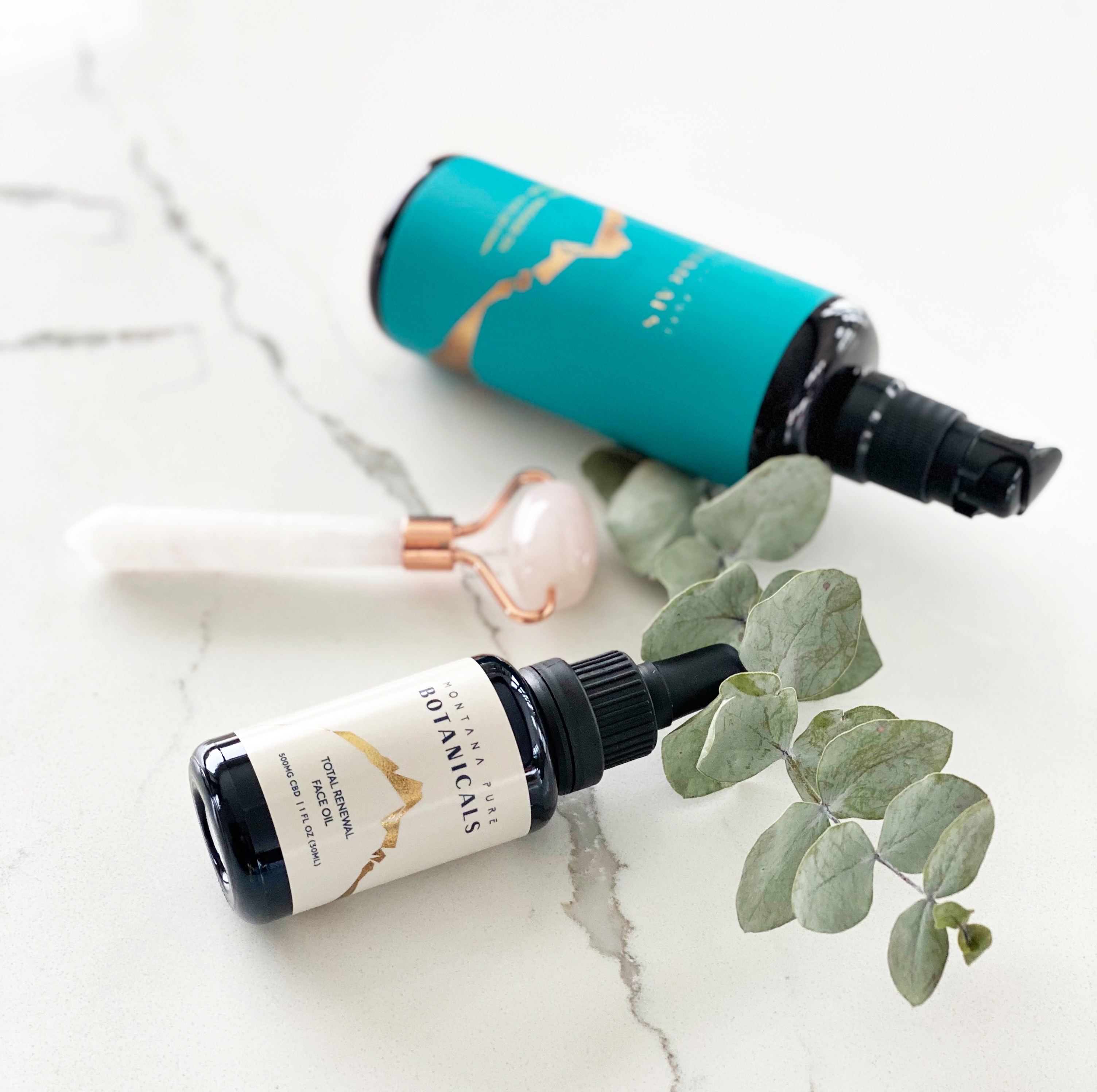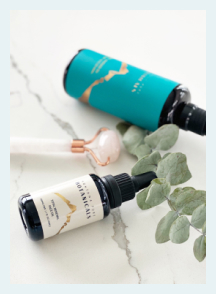Hemp Oil Benefits for Skin
By Dagmara Mach on Jul 15, 2021

Wrinkle reducing, anti-aging, and regenerative skin benefits
Hemp oil compounds achieve anti-aging cellular benefits by targeting the underlying causes of aging skin which is characterized by dryness, discoloration, redness, wrinkles, and loss of facial structure.
Research suggests that the main factors behind skin aging, the development of wrinkles, and impaired cellular regeneration are oxidative stress, mitochondrial dysfunction, collagen loss, clogged pores and acne.
Studies show hemp oil compounds target causes of aging with antioxidant, mitochondrial function improving, collagen-promoting, moisturizing, and acne-combating properties [ 1].
As a result, hemp oil can help to prevent signs of aging from developing, while simultaneously reversing the appearance of existing cellular damage such as fine lines and wrinkles. This is one powerful oil!
Hemp Oil Skin Benefits
Hemp oil contains numerous components including all 20 amino acids, fatty acids such as omega 3s, 6s, and gamma-linoleic acid (GLA), and polyphenols.
These compounds help reduce skin redness, dryness, and a compromised immune barrier. They can be applied directly to the skin in the form of a hemp balm or face oil.
A study of medical students found that when compared to control subjects, students who received omega-3s showed a 14% decrease in production of the cytokine interleukin-6 (IL-6) [ 2].
Amino acids, fatty acids, and polyphenols are sometimes referred to as phenylpropionamides because they all have a phenylpropionamide portion in their molecular structure. Researchers have isolated over 30 phenylpropionamides from hemp seeds [ 3].
I use this CBD massage oil in our massage clinic, our clients love it and some use it in their regular home-care routine. It smells fantastic and has a luxurious feel; the color is green like the plant, and is very earthy. We have been using this product for several months with positive feedback from our clients. I use it personally and I highly recommend this CBD oil as it is a superior and quality oil, made in Montana! - Katie M., Kalispell MT
Antioxidant benefits
Hemp seeds - and therefore hemp seed oil - are rich in natural antioxidants such as phytosterols, tocopherols, and phenolic compounds [ 5].
Antioxidants are substances that prevent or delay oxidative damage caused by reactive oxygen species (ROS) [ 6]. ROS such as free radicals are an unavoidable byproduct of cellular metabolism, and if left unchecked, they will wreak havoc on our cells, leading to damage and even cell death.
Our body’s antioxidant system is responsible for neutralizing ROS, which play a significant role in the pathology of various chronic conditions including cancer, metabolic disorders, neurodegenerative diseases, cardiovascular problems, dermatological diseases, gastrointestinal disorders, and immunity issues [ 7].
Research suggests that the antioxidants found in hemp seed oil are effective at supplementing our body’s natural antioxidant defenses and mitigating various types of ROS [ 8].
Just as there are different types of antioxidants with varying mechanisms of action, there are also different types of ROS that behave in different ways. Thus, not all antioxidants are effective at neutralizing all ROS [ 9].
Specific types of antioxidants have an affinity for specific types of ROS. For example, tocopherols found in hemp seed oil act as antioxidants that prevent the oxidation of unsaturated fatty acids [ 10].
In order to mitigate the negative effects of all of the different ROS produced by the body, it’s important to consume a variety of antioxidants.
Mitochondrial function benefits
Hemp contains various compounds that support mitochondrial function including linoleic and oleic acids as well as various vitamins and minerals.
Maintaining healthy mitochondrial function is of critical importance to skin health and regeneration. Manifestations of skin aging such as wrinkles, dryness, and discoloration are a consequence of mitochondrial dysfunction [ 11].
Increasing evidence in support of the close association between mitochondria and skin health has led both clinicians and aestheticians to consider mitochondria as a therapeutic target for skin health.
In a recent study, researchers were able to reverse wrinkly skin in mice with compromised mitochondria by restoring their mitochondrial function [ 12].
One way to restore mitochondrial function is by promoting mitochondrial fusion, a process by which 2 damaged mitochondria with different genetic defects fuse together to create one healthy mitochondrion.
Fusion counteracts cellular ageing and DNA damage by allowing the compromised mitochondria to individually encode what the other lacks, thus generating all of the necessary genetic components for a functional mitochondrion [ 13].
Oleic acid, an omega-9 fatty acid found in hemp oil may be one way to promote fusion. Researchers have shown that oleate, a salt ester of oleic acid, promotes mitochondrial fusion enabling genetic complementation which restores mitochondrial function [ 14].
The energy generated by mitochondrial respiration is necessary for skin cell renewal and cells cannot regenerate without it’s constant supply. However, mitochondrial respiration also inevitably produces reactive oxygen species that cause oxidative damage and lead to mitochondrial dysfunction if they are not neutralized by the antioxidant system.
Hemp oil is rich in various antioxidants that target and neutralize reactive oxygen species to prevent associated damage. This helps enable the regeneration of skin cells without the negative consequences of oxidative stress from respiration.
Collagen benefits
Hemp seed oil is rich in glycine, proline, hydroxyproline, and arginine, the amino acids that make up collagen, which makes up approximately 30% of the proteins in your body ( 15).
Collagen fibers lend structure and flexibility to our skin and other parts of our body such as bones, muscles, tendons, ligaments, blood vessels and others. However, after we turn 20 years old, studies suggest that our skin produces about 1% less collagen each year thereafter.
Researchers have found that hemp seed oil can promote collagen biosynthesis in vitro as well as that it can inhibit the activity of MMP-9, a compound that degrades collagen [ 16].
MMP-9 is a type of matrix metalloproteinase (MMP) which degrades several extracellular matrix components such as type I and IV collagen, which contribute to the structure and mechanical properties of tissues [ 16]. By inhibiting MMP-9 and thus preventing it from degrading our collagen, hemp seed oil may help to preserve existing collagen stores.
Collagen synthesis plays an important role in skin regeneration and wound healing. The findings showing hemp seed oil’s ability to promote collagen synthesis, suggest it has the potential to improve skin healing and regenerative processes at a cellular level.
Because it is rich in antioxidants, hemp seed oil also helps prevent free radicals from damaging cells and leads to collagen and elastic fiber breakdown.
Non-comedogenic moisturizing benefits
Hemp oil is non-comedogenic, meaning it moisturizes skin without clogging pores. Clogged pores, known as comedones, can take the form of blackheads, whiteheads, or bumps when they become blocked with oil, debris, dirt, or dead cell parts.
There is a comedogenic scale with ratings from 0 to 5. Hemp seed oil has a 0 on the comedogenic scale, meaning it will not clog pores whatsoever. When you look at the ingredients in your skin care products, be sure they all have this quality! The closer the number gets to 5, the higher the likelihood that the oil will clog your pores.
Although our cells naturally produce oil or sebum to nourish the skin, supply antioxidants, and lock in moisture, these abilities diminish as we age, leaving our skin dry, stressed, and in need of hydration.
By not clogging pores, non-comedogenic oils such as hemp oil provide antioxidants and nutrients while allowing the skin to breathe, remain hydrated, clean out waste, and turn over dead cells. This helps keep dry skin supple and oily skin free of acne.
The CBD Face Oil by Montana Pure Botanicals is forever my favorite! I use it twice a day. It’s calming to my skin while hydrating at the same time. It’s helped clear up my completion and the texture of my skin has never been better. - Ashley T., Kalispell, MT
Anti-acne benefits
Hemp oil has several benefits for acne, not the least of which is actually combatting Cutibacterium acnes (C. acnes), the bacteria that causes it. Other benefits include regulating the production of oil, replenishing linoleic acid, and supplying vitamin E to the skin, all of which play a critical role in acne formation.
Acne vulgaris is a disease characterized by the irritation of sebaceous glands which are attached to hair follicles on our skin. Sebaceous glands produce sebum, a mixture of lipids that moisturizes the skin, acts as a first line of immune defense, and is a method of transport by which antioxidants such as vitamin E get from the blood to the skin [ 17].
When sebum production becomes excessive it alters the composition and the oxidant/antioxidant ratio of skin surface lipids, leading to acne [ 18].
Studies show that hemp oil exhibits antimicrobial activity against the C. acnes (formerly Propionibacterium acnes or P. acnes) bacteria. When present on normal skin, C. acnes activates an immune response and changes the lipid composition of the sebaceous glands [ 19][20].
One notable change in sebum composition associated with acne is a decrease in linoleic acid on the skin’s surface, a fatty acid that is abundant in hemp oil. Research suggests that diminished amounts of linoleic acid are one of several factors that lead to acne formation [ 21].
Decreased linoleic acid content doesn't just lead to acne, however. Low levels of this essential fatty acid also lead to impairment of skin barrier immune function, which may make the skin - especially when it is already compromised by acne - more susceptible to environmental pathogens [ 22].
Finally, acne patients have also been observed to have low levels of the antioxidant vitamin E [ 23], which suggests that topical administration of hemp oil which is high in vitamin E may be helpful in treating underlying causes of acne.
Hemp seed oil compounds
Hemp seed is one of the best sources of skin supporting amino acids and fatty acids. It contains the perfect 3:1 ratio of omega-3-linolenic acid and omega-6-linoleic acid, as well as oleic and gamma linoleic acid [ 24].
Hemp seed oils omega 3, 6, and 9 contents are essential for the building blocks of every cell membrane in the body, and its amino acids are responsible for cellular energy production.
The hemp seed is roughly 25% protein, 30% carbohydrates, and 15% insoluble fibre. It also contains carotene, phosphorous, potassium, magnesium, sulphur, calcium, iron and zinc as well as Vitamins E, C, B1, B2, B3, B6, which are critical to skin health [ 24].
In addition, hemp seed oil is rich in lignanamides such as cannabisin A, B, C, etc and other polyphenols, which have antioxidant and antibacterial properties [ 25].
Experience the incredible benefits of hemp oil for your skin with our clean CBD skin care, Total Renewal Face Oil and our Body + Massage Oil daily skin moisturizer. Organic, cold-pressed hemp seed oil is the #1 ingredient in both of these skin care products as a powerful foundation for the benefits of CBD (cannabidiol).
Sources
- Leizer, C., Ribnicky, D., Poulev, A., Dushenkov, S., & Raskin, I. (2000). The composition of hemp seed oil and its potential as an important source of nutrition. Journal of Nutraceuticals, functional & medical foods, 2(4), 35-53.
- Kiecolt-Glaser, J. K., Belury, M. A., Andridge, R., Malarkey, W. B., & Glaser, R. (2011). Omega-3 supplementation lowers inflammation and anxiety in medical students: a randomized controlled trial. Brain, behavior, and immunity, 25(8), 1725-1734.
- Yan, X., Tang, J., dos Santos Passos, C., Nurisso, A., Simoes-Pires, C. A., Ji, M., ... & Fan, P. (2015). Characterization of lignanamides from hemp (Cannabis sativa L.) seed and their antioxidant and acetylcholinesterase inhibitory activities. Journal of agricultural and food chemistry, 63(49), 10611-10619.
- Zhou, Y., Wang, S., Ji, J., Lou, H., & Fan, P. (2018). Hemp (Cannabis sativa L.) seed phenylpropionamides composition and effects on memory dysfunction and biomarkers of neuroinflammation induced by lipopolysaccharide in mice. ACS omega, 3(11), 15988-15995.
- Andre, C. M., Hausman, J. F., & Guerriero, G. (2016). Cannabis sativa: the plant of the thousand and one molecules. Frontiers in plant science, 7, 19.
- Apak, R., Özyürek, M., Güçlü, K., & Çapanoğlu, E. (2016). Antioxidant activity/capacity measurement. 1. Classification, physicochemical principles, mechanisms, and electron transfer (ET)-based assays. Journal of agricultural and food chemistry, 64(5), 997-1027.
- Kaul, N., Kreml, R., Austria, J. A., Richard, M. N., Edel, A. L., Dibrov, E., ... & Pierce, G. N. (2008). A comparison of fish oil, flaxseed oil and hempseed oil supplementation on selected parameters of cardiovascular health in healthy volunteers. Journal of the American College of Nutrition, 27(1), 51-58.
- Prociuk, M. A., Edel, A. L., Richard, M. N., Gavel, N. T., Ander, B. P., Dupasquier, C. M. C., & Pierce, G. N. (2008). Cholesterol-induced stimulation of platelet aggregation is prevented by a hempseed-enriched diet. Canadian journal of physiology and pharmacology, 86(4), 153-159.
- Irakli, M., Tsaliki, E., Kalivas, A., Kleisiaris, F., Sarrou, E., & Cook, C. M. (2019). Effect οf genotype and growing year on the nutritional, phytochemical, and antioxidant properties of industrial hemp (Cannabis sativa L.) seeds. Antioxidants, 8(10), 491.
- Kriese, U., Schumann, E., Weber, W. E., Beyer, M., & Brühl, L. (2004). Oil content, tocopherol composition and fatty acid patterns of the seeds of 51 Cannabis sativa L. genotypes. Euphytica, 137(3), 339-351.
- Sreedhar, A., Aguilera-Aguirre, L., & Singh, K. K. (2020). Mitochondria in skin health, aging, and disease. Cell Death & Disease, 11(6), 1-14.
- Singh, B., Schoeb, T. R., Bajpai, P., Slominski, A., & Singh, K. K. (2018). Reversing wrinkled skin and hair loss in mice by restoring mitochondrial function. Cell death & disease, 9(7), 1-14.
- Hales, K. G. (2010). Mitochondrial fusion and division. Nature Education, 3(9), 12.
- Westermann, B. (2010). Mitochondrial fusion and fission in cell life and death. Nature reviews Molecular cell biology, 11(12), 872-884.
- Rodriguez-Leyva, D., & Pierce, G. N. (2010). The cardiac and haemostatic effects of dietary hempseed. Nutrition & metabolism, 7(1), 1-9.
- Jin, S., & Lee, M. Y. (2018). The ameliorative effect of hemp seed hexane extracts on the Propionibacterium acnes-induced inflammation and lipogenesis in sebocytes. PLoS One, 13(8), e0202933.
- Ekanayake-Mudiyanselage, S., & Thiele, J. (2006). Sebaceous glands as transporters of vitamin E. Der Hautarzt; Zeitschrift fur Dermatologie, Venerologie, und verwandte Gebiete, 57(4), 291-296.
- Zouboulis, C. C. (2004). Acne and sebaceous gland function. Clinics in dermatology, 22(5), 360-366.
- Ryu, A. R., & Lee, M. Y. (2017). Chlorin e6-mediated photodynamic therapy promotes collagen production and suppresses MMPs expression via modulating AP-1 signaling in P. acnes-stimulated HaCaT cells. Photodiagnosis and photodynamic therapy, 20, 71-77.
- Wang, Y. Y., Ryu, A. R., Jin, S., Jeon, Y. M., & Lee, M. Y. (2017). Chlorin e6-mediated photodynamic therapy suppresses P. acnes-induced inflammatory response via NFκB and MAPKs signaling pathway. PLoS One, 12(1), e0170599.
- Downing, D. T., Stewart, M. E., Wertz, P. W., & Strauss, J. S. (1986). Essential fatty acids and acne. Journal of the American Academy of Dermatology, 14(2), 221-225.
- Cunliffe, W. J., Holland, D. B., & Jeremy, A. (2004). Comedone formation: etiology, clinical presentation, and treatment. Clinics in dermatology, 22(5), 367-374.
- Picardo, M., Ottaviani, M., Camera, E., & Mastrofrancesco, A. (2009). Sebaceous gland lipids. Dermato-endocrinology, 1(2), 68-71.
- Borhade, S. S. (2013). Chemical Composition and Characterization of Hemp (Cannabis sativa) Seed oil and essential fatty acids by HPLC Method. Archives of applied science research, 5(1), 5-8.
- Frassinetti, S., Moccia, E., Caltavuturo, L., Gabriele, M., Longo, V., Bellani, L., ... & Giorgetti, L. (2018). Nutraceutical potential of hemp (Cannabis sativa L.) seeds and sprouts. Food chemistry, 262, 56-66.





